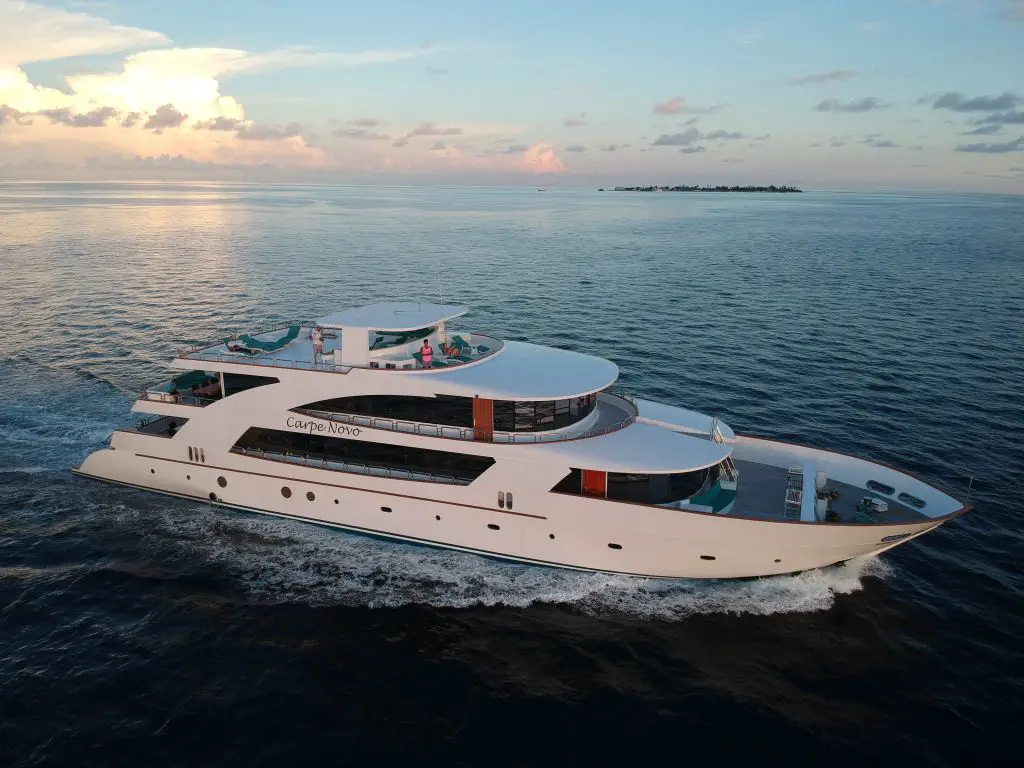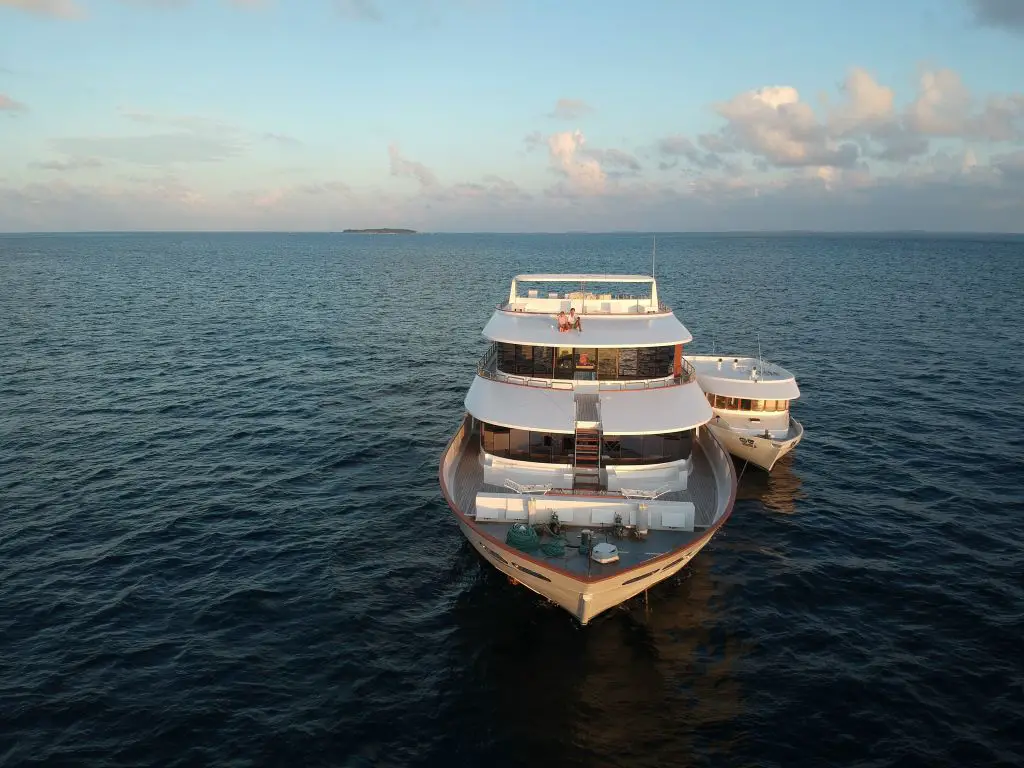
Liveaboard diving is the pinnacle of what scuba diving offers. Imagine yourself on an amazing vessel drinking in the sea and diving some of the most spectacular sites in the world. Passionate divers like myself looking for a more unique and engaging experience should seriously consider going on a liveaboard where you’ll do nothing but eat amazing food, and dive the best dives in the world.
This is a guide I’ve written that will go over every possible detail you’ll ever want or need to know about taking a liveaboard dive trip. If you are considering a liveaboard or are about to go on your first liveaboard trip, make sure to read this so you know what to expect!
List of liveaboard posts:
- Carpe Novo – Best of Maldives
- Discovery liveaboards in Egypt – Brothers, Daedalus, Elphinstone
- Raja Ampat – Central and South
What are liveaboards?

A liveaboard is exactly what it sounds like. You are living aboard the boat that you’re diving on. This might sound like hell facing the ocean’s waves for a week straight, but others take solace in the fact that you’re surrounded by nothing but water. Liveaboards have taken off tremendously in the last 20 years and in fact, are the only way to dive in the more remote areas of the world.
The purpose of a liveaboard dive boat is to take a group of divers around an amazing area and just dive all day every day. They are fitted with living quarters, bathrooms, and dining is all included. Don’t book a liveaboard if you want the comforts of land at the end of the day. You are doing everything on the boat. Most boats will not dock for the duration of the trip outside of maybe a beach dinner or two.
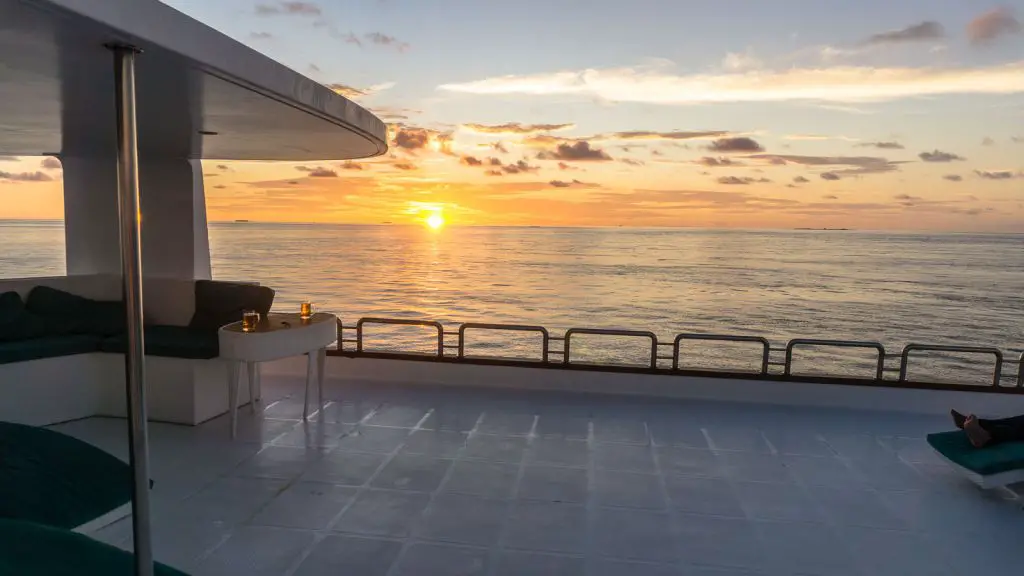
Liveaboard boats are of course much larger than your normal Newton boats that are used for day trips. They can be yachts that are 40m long and 20m high!
Top notch services
Liveaboards are a hotel, restaurant, and dive resort in one boat. Expect the service from the crew to be top notch. You are paying for the diving, but also for the experience as well. I was always greeted with smiles from the boat crew after all my dives. Expect the boat and your room to be cleaned regularly as well.

For the diving, most everything will be done for you from cleaning the equipment, setting up your equipment, filling your tanks, checking your nitrox etc. In fact, on most boats you just have to open your arms, get suited, and jump in. Liveaboards are full service diving
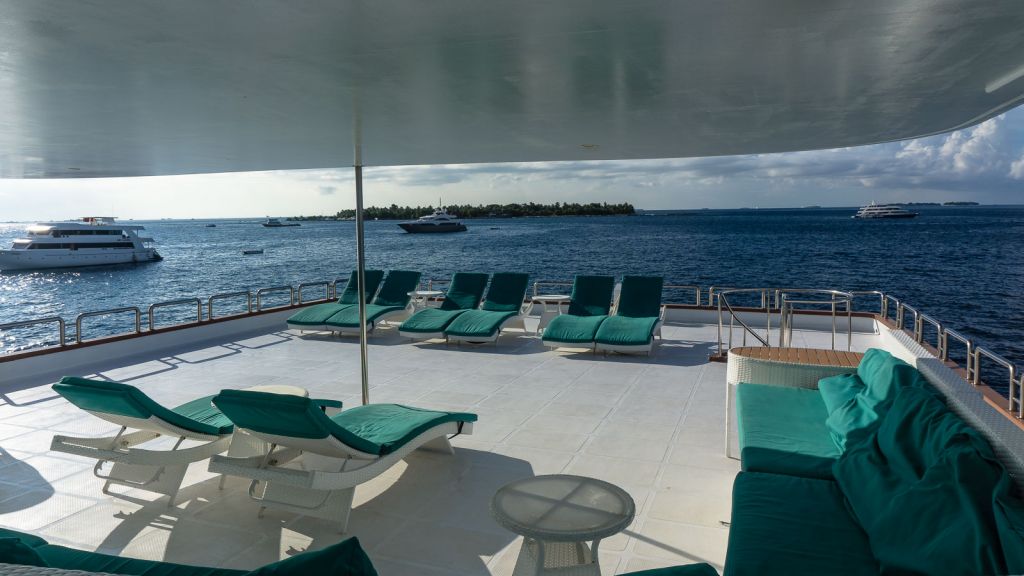
Why liveaboards are the ultimate diving experience
Obviously this is completely based on personal opinion. I think liveaboards make for the best diving experiences you can have. This is not only because of the fact that you may stay on a beautiful boat and have top notch service for your trip, but because of the diving itself.

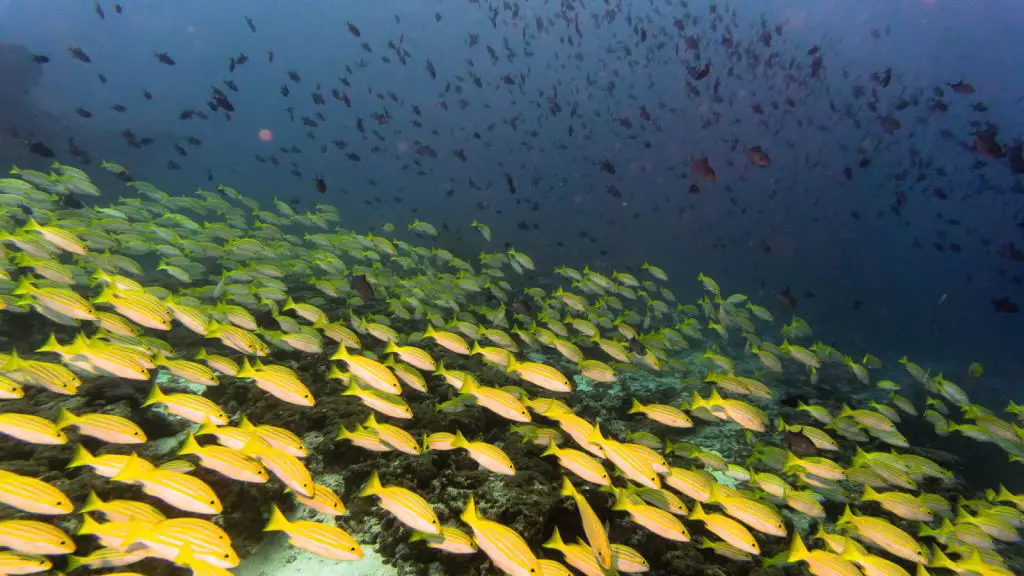
Liveaboards sail for the entire week, at all hours of the day if necessary, meaning you can visit places that are far out and impossible to reach as a day trip from land. For example, many of the best diving in the world exists far away from civilization. The Galapagos, Red Sea, Socorro, Raja Ampat, etc. are places where you can’t visit in a day. Socorro for example is a full 20 hours boat ride from the mainland of Mexico! As the old saying goes, good things come to those who wait!
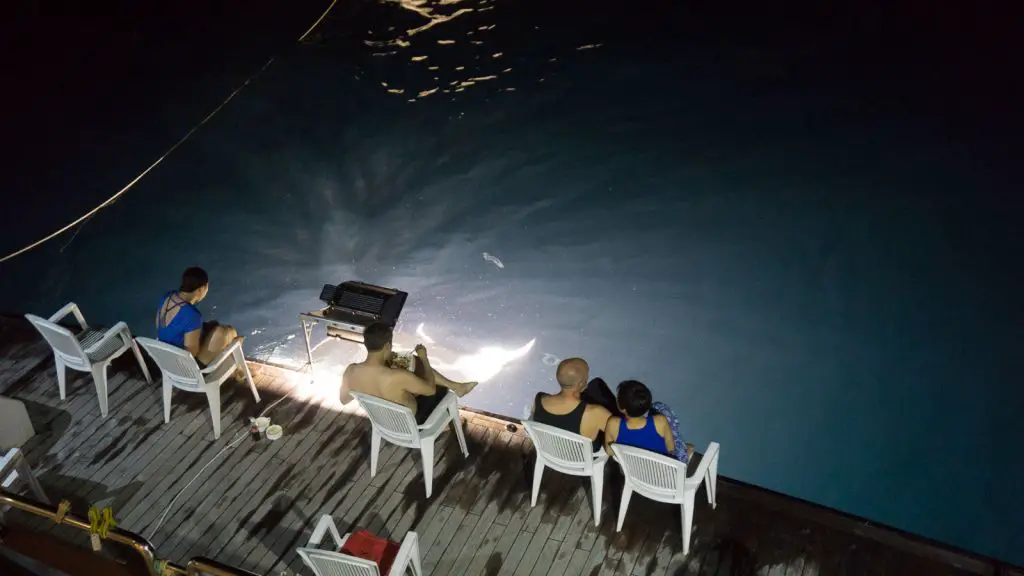
Again, not all liveaboard boats are created equal. Some are brand new, luxurious yachts, while others can look like a refitted fishing boat.
Skill level for liveaboards
Liveaboards are not meant for the complete beginner. If you’ve recently passed your open water certification and are ready to take on the world, liveaboards may not be the best place to test your mettle after five dives. Liveaboards often require that you be Advanced Open Water certified with a minimum number of dives (sometimes 25, sometimes 50+). Some liveaboards will check your log book, others won’t so it would be wise to always bring this with you as well.
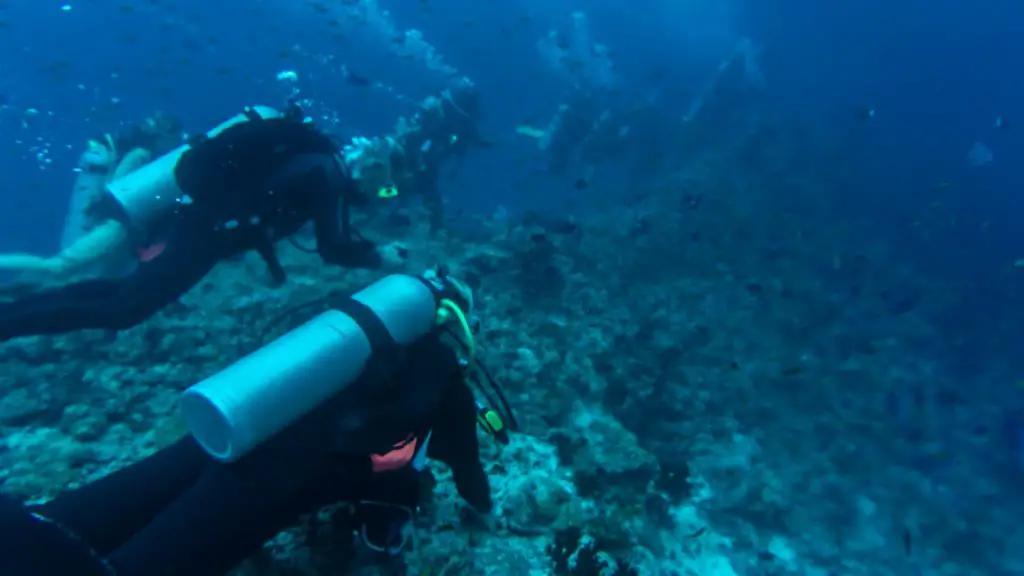

Nevertheless, you can be an AOW diver with 10 dives but that is absolutely no substitute for experience. Liveaboards travel further out into the ocean and generally visit sites that have more current and can be more challenging to the beginner. As any seasoned diver knows, currents can be challenging but are also essential to bringing in the big fish. Do research on where you are diving before you go and make sure you know what you’re getting yourself into!
Dive Courses on the liveaboard
Liveaboards always have instructors on board as well and you can do courses here as well. If you are not AOW certified, a liveaboard is the perfect place to do it! Nitrox is another popular course that many people do on liveaboards. With the amount of diving you do, I always recommend people dive with Nitrox.
You can expect reasonable prices for these courses and for them to be in line with what the local dive shops in the area charge.
Tipping on a liveaboard
Tipping on a liveaboard is a confusing and subjective issue. How much should you tip? Do I tip the guides and the crew separately? When do I tip?
Liveaboard tipping is of course not mandatory but it is expected especially if you’ve enjoyed your experience. For the crew and the dive guides, how much the guests tip can be a considerable amount of their total compensation.
How much to tip?
As a general guideline and after speaking with many of my dive friends, I think something in the 5 to 10% range is a good tip for liveaboards. Alternatively, $100 to $200 for a 7 day trip is also very reasonable in my opinion if you don’t want to perform any calculations. In the end, liveaboards already cost a lot of money so no one is expecting you to fork over hundreds more dollars just because. If you’re going on a $6,000 liveaboard in the Galapagos, 5 to 10% is $300 to $600 which is just a lot of extra money to come up with.
Americans reading this might automatically think 20% as this is what they’re used to at restaurants. While you are certainly free to tip as you feel, I think this is way too much.
Who to tip?
Normally, the crew including the maintenance staff, cooks, dive staff, and boat captain will share the tips. How they allocate the tips among themselves I’m not sure but they will just have a pot where everyone can put their money in. Alternatively, if someone’s service resonated with you in particular, feel free to tip them accordingly. I tipped my dive guide $50 in person, and another $100 in the shared pot.

When to tip?
Tipping is always done at the end of the trip, after you’ve had a satisfactory trip. Normally it is done the last night when you settle up any tabs you have for drinks and extra dive expenses. Cash is obviously king but there are liveaboards that will accept tip via credit card which is of course a great way of earning points.
What is the boat like
There are hundreds of liveaboard boats out there in the world so expect the full range of boats from the budget to the ultra luxurious. Depending on where you are, the design of the boats can be different too to mirror the local styles. For example, the liveaboards in much of Raja Ampat and Komodo mirror the traditional fishing boat style Jukong but in a larger and more dive-fitted format.
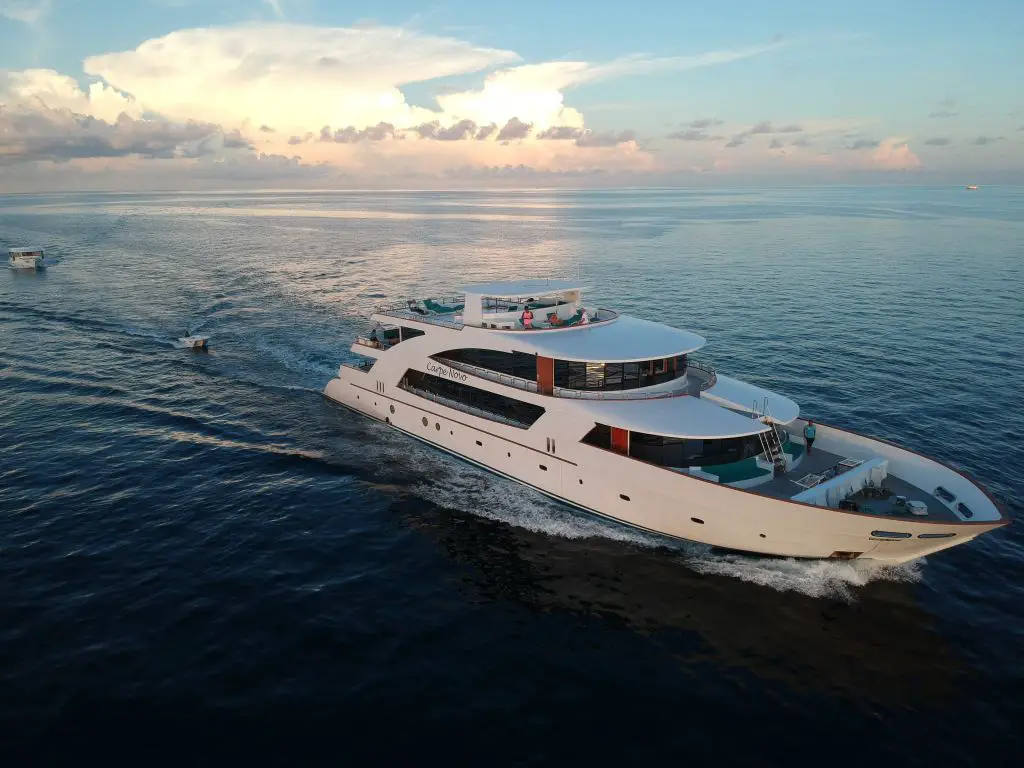
Diving schedule
Hopefully this comes as no surprise, but expect to dive. A lot. The motto of liveaboards is after all, “Eat. Dive. Sleep. Repeat”
Every liveaboard will have slightly different schedules depending on the location but for the most part, will adhere to same theme. Something along these lines will be what you can expect:
6:00 to 6:30am: Wake up
6:30am to 7:00am: Dive briefing
7:00am to 8:30am: Load up the dhoni, go to dive site and complete our dives
8:30 to 9:30am: Breakfast
9:30 to 10:30: Surface interval
10:30 – 12:00: Second dive briefing and dive
12:00 – 13:00: Lunch
13:00 – 14:30: Surface Interval
15:00 – 17:00: Third dive briefing and dive
19:00: Dinner

The beauty of a liveaboard is everything is on your schedule. You can choose to dive or not. If four dives are too much in a day, you can always do the morning dives and relax on the boat for the afternoon. You pay the same price whether you go on 100% of 50% of the dives, but you are free to choose between diving and relaxing. As I get the worse case of dive FOMO, I made sure to go on every dive but that is entirely my choice!
The other divers on the boat
Your fellow dive mates will hail from all countries, backgrounds, age, and dive skill. One thing is certain, they all share a passion for diving. No one just casually goes on a liveaboard. People know what they’re getting themselves into being on a boat for a week but they actively seek it. Therefore, you’ll definitely meet some interesting people on board and you can be sure to find others that share your passion for diving. My favorite part is talking about where everyone else has dived, their favorite locations, and watching media they’ve obtained.

Forget blogs and magazines, this is the best form of research possible!
Food and alcohol
Liveaboards are famous for having great dining. After all, there’s nothing filling up a hungry stomach after a dive. I seem to always find space to eat after a good dive, and the liveaboard is the perfect place to satisfy. A real chef is always part of the crew and is responsible for making breakfast, lunch, and dinner for the guests.
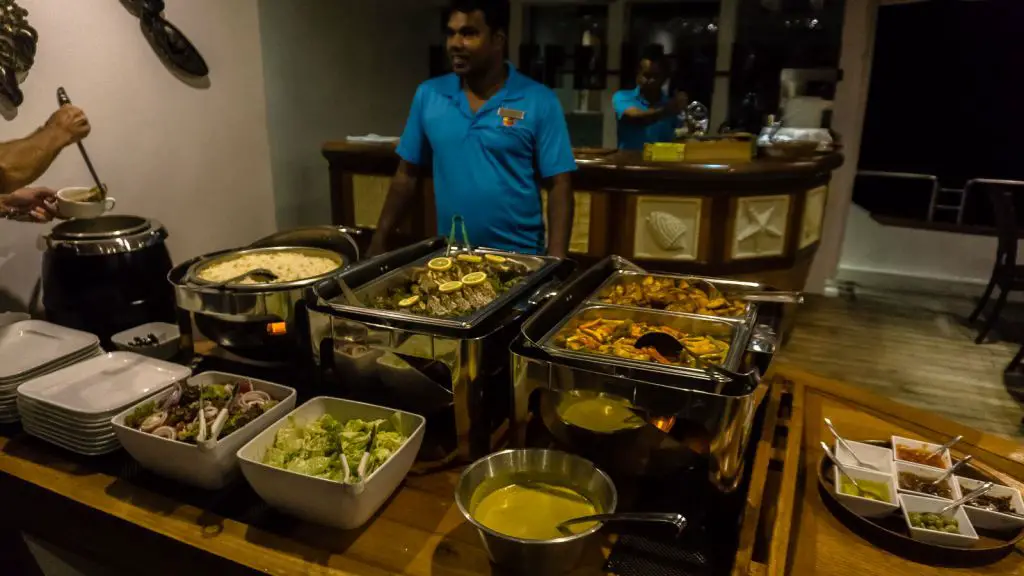

Liveaboards normally will offer cuisine of the region, as well as your standard Western fare. Food is served buffet style with meats, fish, rice, pasta, fruits, and other veggie friendly options. You can skip meals of course if you’re not hungry, as well as ask for special food depending on your diet restrictions. For example, many divers do not eat fish and the chef will make sure to have land meats available. On my Maldives liveaboard, we had snacks available at all times of the day even though I was always stuffed from the meals.

I’ve only been on one liveaboard in the Maldives, but many of my fellow divers were well versed in liveaboards. Regardless of the price, they all had positive things to say about the food on the liveaboards they had been on. One thing is for certain, there is an abundance of food and you will never go hungry.
Alcohol and other things
There’s nothing than finishing a day of epic diving with a beer and sunset. Don’t worry, every liveaboard I’ve seen offers alcohol. Beer, wine, and a selection of liquor are all offered. Liveaboards in the Red Sea will even offer shishas on board! Prices will vary depending on where you are of course but from my experience, the prices are all quite reasonable. For example, on my Maldives liveaboard, the price of a draft beer was $4 USD. Wine was the same price. Compared to the Park Hyatt Resort in the Maldives that charged $9 for a beer and $14, this was very reasonable.
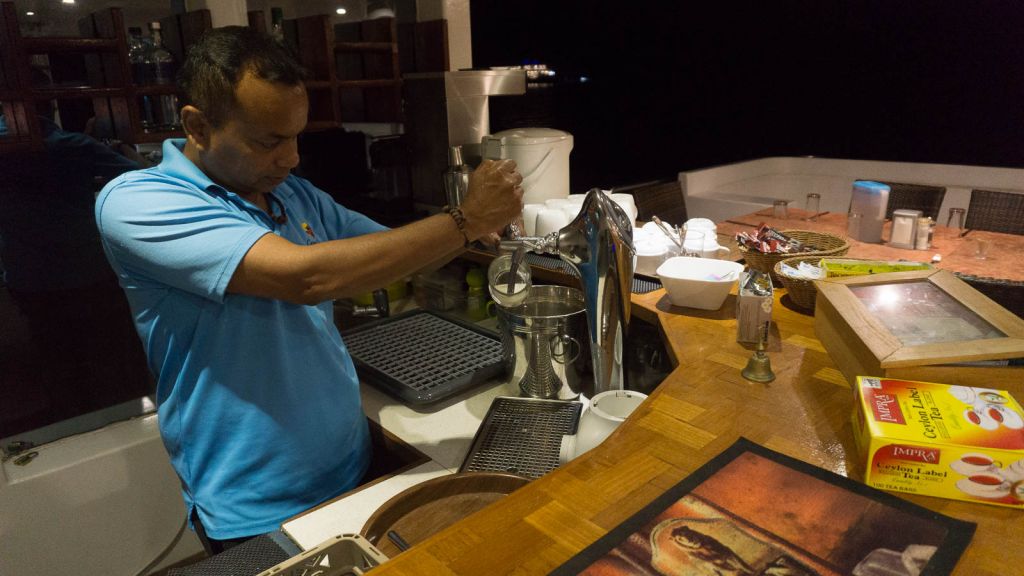
A staff member will record all your drinks for the trip and you will settle it all up at the end of the trip.
How to choose destination
Choosing your liveaboard should be based on a few criteria. Make sure you understand what you’re getting yourself into and be fully prepared!
Season
For most diving destinations, season is one of the most important things to consider. Different times of year will mean different diving conditions, different marine life, and different weather.

If you’re spending the money to go on a liveaboard, try and go during the best times of year. This is not always feasible and “low season” doesn’t always mean worse diving, but there’s a reason there is a high season and low season when it comes to diving.
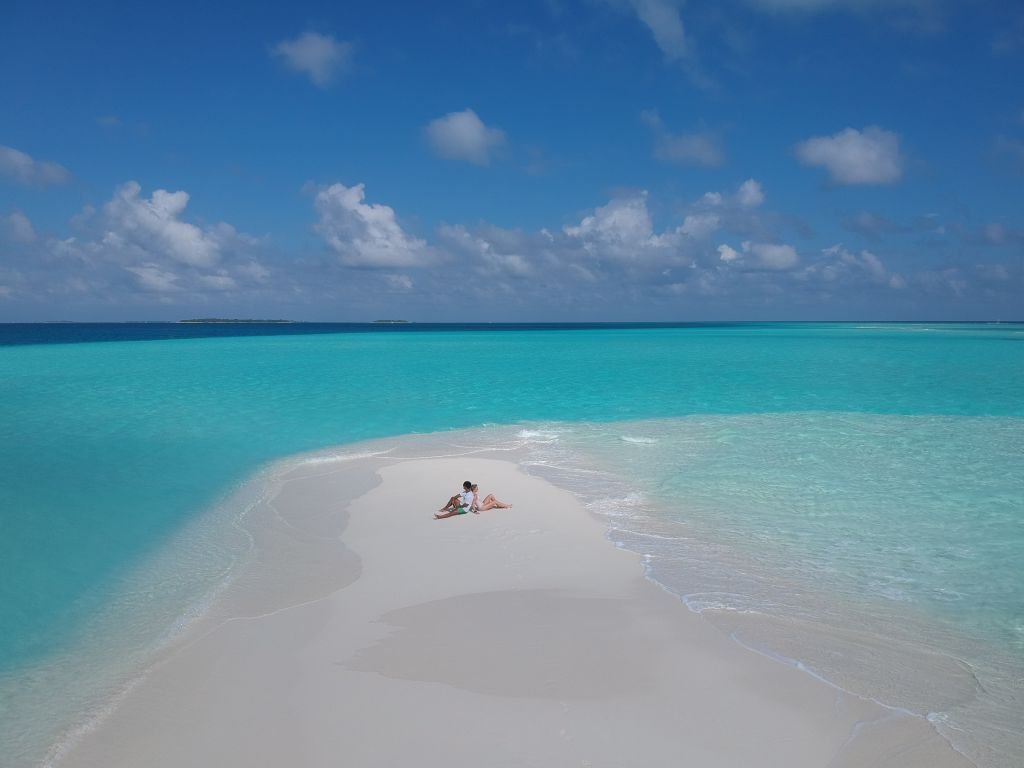
What you want to see
Research research research! Think about what you want to see and what kind of diving you want to do and plan for it. Do you want to see Mantas? Maybe Komodo during the wet season is the best option for you. Hammerheads? Maybe Daedalus Reef in Egypt or anywhere in the Galapagos.

Better yet, talk to other divers to hear their first hand recounts and what to expect.
Skill
Always research your dive destination before and what to expect. I think the main questions to ask here is how strong are the currents, and how choppy is the surface? Take stock of your own skill level and how well you do in these conditions before booking a liveaboard. There’s nothing worse for someone uncomfortable with currents to show up in Komodo and find out that the whole national park is just one big current.
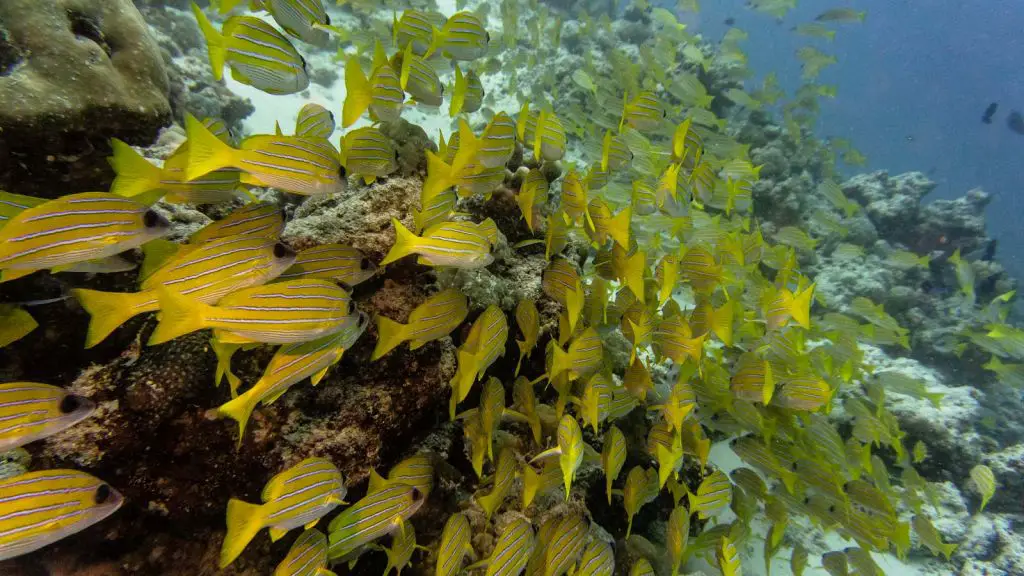
Cost
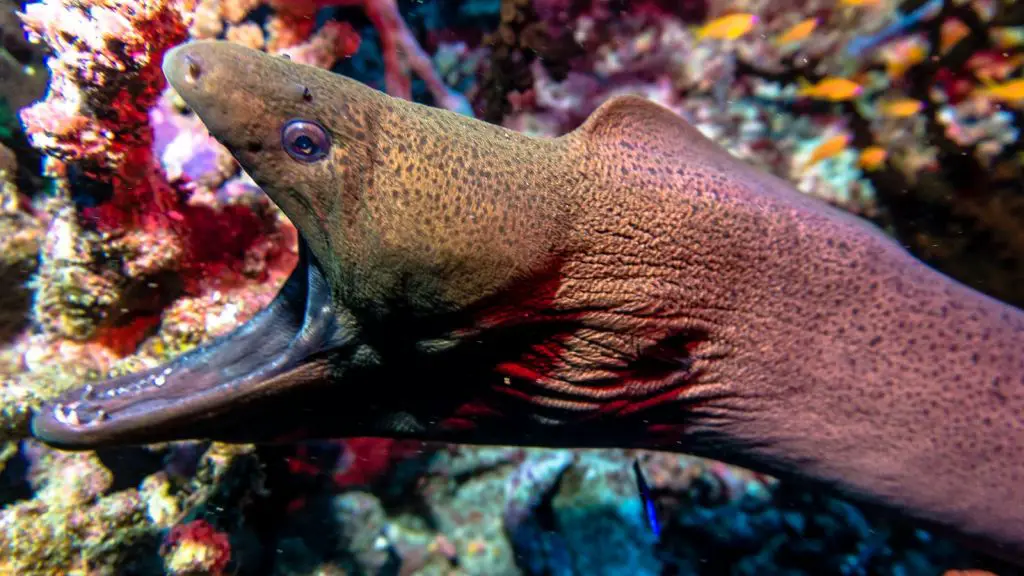
The cost of liveaboards vary drastically depending on the location, the boat quality, and the season. Expect to pay more when it is during that liveaboard’s “high season” because the high season is likely when the most interesting things come into the picture.
The best way to save on costs is to be flexible, travel in the low season, or both. If you can book a liveaboard last minute, you can expect serious savings as boats look to fill out their last spots at any price they can get.
What to pack
Make sure to have all your necessities with you. Once you’re on the boat, it travels at sea for the duration and you won’t be able to stop and get supplies. Most liveaboards will provide the basics like towels, shampoo, dive equipment, dive maintenance equipment but make sure to bring everything else.
- toiletries
- Sunscreen
- camera equipment
- diving equipment including computer, knife, torch
- comfortable clothes for the weather at hand
- medication
- sunglasses
- dive certificate, dive insurance
- chargers and extra batteries
How much does it cost

Liveaboards are considered a “premium” experience compared to your standard dive resorts. Of course you can spend insane amounts on diving like I did at the Park Hyatt Hadahaa but that is the exception to the rule. The prices of liveaboards vary drastically on the location. There is no formula to figuring out the cost but rather it just is what it is. Just because the country the liveaboard is traveling through is “cheap” has little correlation with how much the liveaboard will cost.

For example, Ecuador is not an expensive country to travel through but the Galapagos are an exception and you will see liveaboards here cost well over $5,000 for a week. Alternatively, the Maldives which is known for its glitzy resorts and ultra-expensive luxury, has some of the cheapest liveaboards in the world. I went on a liveaboard with the Carpe Diem fleet for $2,000. Raja Ampat, one of the jewels of Indonesian diving, runs somewhere in between the two. Again, there’s no rhyme or reason.

Liveaboards are not created equal. Some liveaboards are much more luxurious and offer more amenities, and these will of course cost more and target older crowds. There are budget liveaboards all over and you will get what you pay for. You may have to bunk it up with someone, the bathroom will be standing only etc. but you will save a lot. From my experiences talking to other divers, I’ve rarely met someone that has done budget liveaboards complaining about the food, which is great.
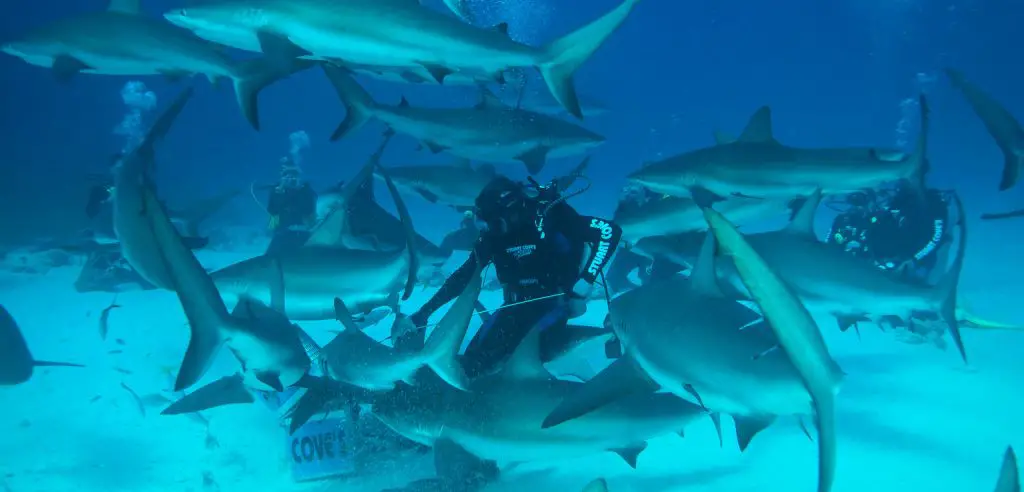
Prices will of course also vary depending on length of trip. There are liveaboards as short as 3 days, and some over two weeks! Expect to pay less or more depending on nights on the boat.
Of course, if you are lucky enough to have a flexible schedule, waiting until the last minute can often times result in discounted (sometimes extremely discounted) rates as boats try to sell their remaining seats.
What does it include and not include
Generally, liveaboards include the room, food, towels, water, and all diving associated with the trip. This can be up to 4 or even 5 dives a day depending on the boat.
Extra costs are the following, although some boats will include this without charge:
- Alcohol
- Soft Drinks
- Nitrox
- Diving equipment
- Upgrading to a nicer room on the boat, aka top floor vs basement floors
- Dive torch
Cheapest places to do liveaboards
By far, the cheapest place to do a liveaboard is in Egypt. The diving around the Red Sea is fantastic and the boats in Egypt leave regularly. From Sharm El Sheikh, Marsa Alam, or Hurghada, you can find liveaboards that cost under $1,000 on a regular basis. These are not budget liveaboards either. Egypt is just a fantastically cheap country, and the cost of fuel is so low that they can get away with charging such low prices. Neighboring Sudan also has very affordable liveaboards with similar diving.

After Egypt, you can find many liveaboards in the Maldives, Thailand, and other parts of Southeast Asia in the $1,000 to $2,000 range.
Where to book?
There are many places to book liveaboard trips. Normally it is done through a booking or travel agency that specializes in dive safaris like this. My preferred vendor is divebooker.com. They offer all the liveaboards out there and have great customer service. They also offer free DAN insurance which can be over $100 for a week long liveaboard. Travel insurance is required for liveaboards. Liveaboards don’t mess around with checking your



